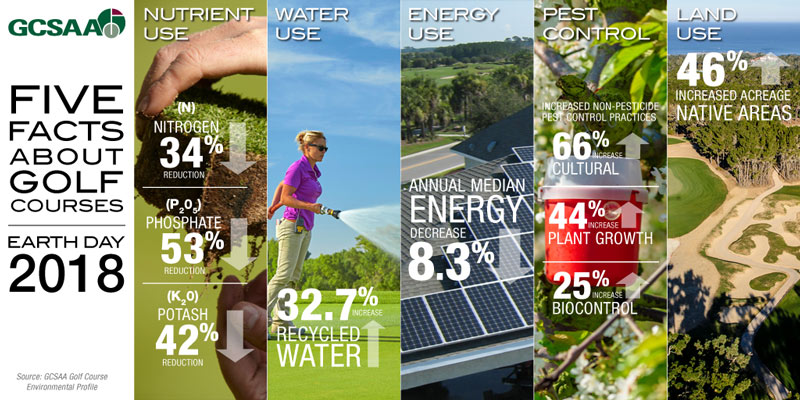
Since 2006, GCSAA has been conducting a groundbreaking project, the Golf Course Environmental Profile (GCEP), to develop a comprehensive environmental profile of golf courses in the United States. The first phase of the five-survey study developed a baseline of data, and the second phase, completed in 2017, was used to measure change with updated trend analysis.
The surveys have provided critical data on land use, inputs, management of natural resources and environmental stewardship associated with golf courses.
In honor of Earth Day on Sunday, April 22, here are five ways golf courses have shown improvement in the past decade, as documented in the GCEP.
1. Energy use
Annual median energy use at U.S. golf facilities has decreased 8.3 percent. This was primarily the result of a 31.4 percent decrease in consumption of electricity since 2008.
2. Nutrient use
U.S. golf courses have significantly decreased overall nutrient use since 2006, including a 34 percent reduction in nitrogen, a 53 percent reduction in phosphate and a 42 percent reduction in potash.
3. Pest management
Golf courses have increased their reliance on non-pesticide pest control practices such as cultural control, plant growth regulators and biological control.
4. Land use
The amount of maintained turfgrass on an average 18-hole golf course has decreased from 99 to 95 acres, with 46 percent of average 18-hole courses having increased natural-area acreage.
5. Water use
Use of recycled water has increased by 32.7 percent. Recycled water now counts for 25 percent of all water used on golf courses, thereby reducing the use of surface, ground and potable water sources.
“Golf course superintendents are committed to their role as environmental stewards,” says GCSAA CEO Rhett Evans. “The Golf Course Environmental Profile helps us document and share the many ways they are implementing change for the betterment of the environment.”
The GCEP was created with funding through GCSAA’s philanthropic organization, the Environmental Institute for Golf (EIFG). The EIFG partnered with The Toro Giving Program to fund the first phase of the project. In 2014, the second phase of the project was funded in partnership with the USGA.
View the full reports from both phases of surveys in the Golf Course Environmental Profile.